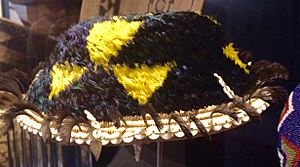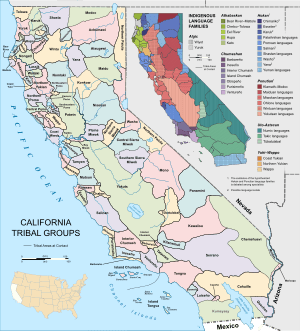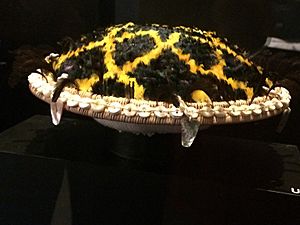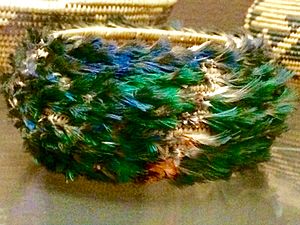Fully feathered basket facts for kids
A fully feathered basket is a special type of basket. It was made by some Native American groups in Northern California, near the coast above San Francisco. These baskets are easy to spot because they are completely covered with soft feathers on the outside. People really value these baskets for their beautiful art and amazing skill.
Contents
What are Fully Feathered Baskets?

Fully feathered baskets are traditional baskets made by Native American tribes in California. They have a thick layer of feathers covering their whole outside. Sometimes, they also have beads and hanging decorations. These baskets show off the artists' culture and their amazing talent. People all over the world respect these beautiful works of art.
Only a few tribes in Northern California made these special baskets. These include the Pomo, Coast Miwok, Wappo, Patwin, and Lake Miwok tribes. The skills needed to make such baskets were learned over many years. Knowledge was usually passed down from one generation to the next within a family. While these tribes made other types of baskets, the fully feathered ones are the most famous. This is because of the colorful, shiny feathers used on them.
Sometimes, baskets made by different tribes looked very similar. But some fully feathered baskets have small details that show which tribe made them. These baskets were very personal items. They were often given as gifts. Sadly, they were sometimes destroyed when the owner passed away. This tradition made the baskets very rare. Also, some tribes faced big changes when Spanish missions arrived. This led to the loss of many cultural practices, including basket making. Later, in the 1900s, some fully feathered baskets were taken by government agents. This happened because laws restricted owning certain bird feathers.
How are Fully Feathered Baskets Made?
Traditionally, women were the main creators of fully feathered baskets. Only a few men made them. Not all weavers made feathered baskets. Some weavers preferred them so much that they only made other baskets if feathers were not available. Weavers often followed certain rules when making baskets. This helped them feel connected to nature and each other. For example, weavers would not work on baskets if they felt unhappy. Some would fast before gathering materials. They would also pray when collecting plants. As Julia F. Parker, a famous weaver, said, "We take from the earth and say please. We give back to the earth and say thank you."
Some basket makers wove special breaks into their baskets. These breaks were called daus. They were like a small opening that allowed the basket's spirit to check the basket.
Materials Used
The baskets were woven using natural plant materials. Then, feathers were added to cover the entire outside surface. Common plant fibers included sedge rhizomes and willow shoots. Many different native bird feathers were used for their colors:
- Bluebird and bluejay feathers for blue.
- Acorn woodpecker head feathers for red.
- Quail topknots for black.
- Oriole feathers for yellow or orange.
- Meadowlark breast feathers for yellow.
- Mallard head and neck feathers for green.
Later, when laws limited the use of some feathers, others like pheasant feathers were used instead.
Adding the Feathers and Decorations
The feathered layer on the outside of the basket had to be pressed flat. Delvin Holder, whose mother Suzanne Holder was a master basket maker, explained her method. She would first pinch off the feathers at the base so they spread out. After trimming them evenly, she would tie a cloth around the basket. She would leave it for two or three days. After this, the feathers would lie flat all around the basket.
One basket made by Annie Dick Boone had 233 small feathers, each about a quarter-inch long. These baskets were usually much smaller than large carrying baskets. They were often less than a few inches across, about the size of an adult hand. Some are so tiny that museums call them miniatures.
Baskets mostly covered with red feathers were often called sun baskets. After the feathers were added, more decorations might be put on. The edges could be decorated with beads made from local materials. These included white clam shell disc beads or beads made of magnesite. These beads were valuable, and magnesite was especially precious. These beads decorated baskets in different ways, sometimes hanging in strands. Abalone shells, and later glass beads, were often used to add a shiny, iridescent look. These also hung in gleaming strands on some baskets. Sometimes, a small strap was added so the basket could be hung up.
Sherrie Smith-Ferri, who has Dry Creek Pomo and Bodega Miwok heritage, described these decorated baskets. She said non-Native collectors called them "jewel baskets." Like jewels, they shimmer with rich color and were treasured as a form of wealth. She also said that when hanging, these jewel baskets become "creatures of motion, more like dancing mobiles than stationary containers."
Keeping Fully Feathered Baskets Safe
From the 1880s to the 1930s, there was a strong demand for real, traditional baskets. This market was mostly for the finer baskets, which women usually made. Some men also learned these basket-making skills and became very successful. For example, the Pomo couple William and Mary Benson (Mary was the daughter of master basket maker Sarah Knight) made many high-quality baskets. They worked closely with art dealers and collectors across the country. Their baskets are now kept in famous museums like the Smithsonian Institution, the National Museum of the American Indian, and the Field Museum of Natural History.
Two Pomo tribe members, Elsie Allen (1899–1990) and her mother Annie Burke (1876–1962), did a lot to help preserve these baskets. They went against Pomo tradition. Annie Burke asked her daughter, Elsie Allen, to keep her baskets safe after she passed away. Elsie Allen did this successfully. She also continued to collect baskets and shared her knowledge with anyone who wanted to learn, no matter their background. Elsie Allen herself had some baskets taken by the state because of laws about feathers. So, she hid her baskets to protect them. At that time, it was rare for baskets to be saved this way.
Elsie Allen also broke another long-standing tradition to make sure Pomo basket making would continue. She wrote a book that explained how to weave Pomo baskets. This was the first time a Pomo person had shared weaving skills outside of their family. Even though many people disagreed with her at first, she successfully shared her knowledge this way.
Today, fully feathered baskets are kept in many museums around the world. These include the Kunstkamera in Saint Petersburg, Russia; the Buffalo Bill Center of the West; the Smithsonian's Heye Center at the National Museum of the American Indian in New York City; and the Grace Hudson Museum in Ukiah, California.




